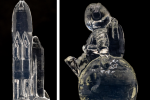
3D Printed Hydrogels Improve Radiation Protection for Astronauts
3dprintingindustry.com
Scientists at Ghent University, a research institution specializing in polymer chemistry and biomaterials, are evaluating 3D printed hydrogels as a radiation shield for astronauts. These materials, which can absorb and retain large amounts of water, could offer a safer alternative to traditional shielding methods. The research, conducted in collaboration with the European Space Agency (ESA), aims to solve challenges associated with using water as a radiation shield by incorporating it into superabsorbent polymers (SAPs) that can be 3D printed into stable structures.Illustration of space radiation shielding. Image via ESA.Astronauts traveling beyond Earths atmosphere and magnetic field experience high doses of cosmic radiation from solar flares and deep-space sources. A single day in space exposes them to as much radiation as an entire year on Earth. For long-duration missions to the Moon or Mars, shielding must be lightweight, effective, and adaptable to different environments.Studies have shown that water is an effective radiation barrier, but using it in liquid form presents technical challenges. Rigid containers could restrict astronaut movement, cause uneven coverage, or risk leaks in case of punctures. According to the Ghent University research team, hydrogels may offer a solution by retaining water in a stable, non-leaking form, ensuring uniform shielding while remaining flexible.Hydrogel in action. Image via ESA.3D Printed Hydrogels Provide Structural StabilityThe Polymer Chemistry and Biomaterials Group (PBM) at Ghent University specializes in developing polymer-based materials for medical and industrial applications. As part of this research, the team is using 3D printing to shape hydrogels into custom radiation shields.The beauty of this project is that we are working with a well-known technology, said Lenny Van Daele, a researcher on the project. Hydrogels are found in many things we use every day, from contact lenses to diapers and sanitary products. Our research group has experience with applications in the medical fieldusing hydrogels as a soft implantable material to repair damaged tissues and organs.Unlike free-flowing water, 3D printed hydrogel structures retain water in a stable form, making them easier to integrate into spacesuits and spacecraft. The materials ability to hold water without leaking also ensures consistent protection, even if damaged.The superabsorbent polymer that we are using can be processed using multiple different techniques, which is a rare and advantageous quality amongst polymers, said Manon Minsart, another researcher on the project. Our method of choice is 3D printing, which allows us to create a hydrogel in almost any shape we want.3D printed hydrogel space shuttle and astronaut. Photo via Ghent University.ESAs Previous Research Supports Hydrogel ApplicationsAn earlier ESA Discovery project explored hydrogels as a potential space material and demonstrated their viability for shielding applications. The current research expands on those findings by refining 3D printing techniques to create functional radiation shields.There is a constant search for lightweight radiation protection materials, said Peter Dubruel, lead scientist on the project. In our Discovery activity, we successfully demonstrated that hydrogels are safe to use under space conditions. In this follow-up project, we are applying different techniques to shape the material into a 3D structure and scale up the production process, so that we can come a step closer to industrialization.ESAs Materials, Environments, and Contamination Control Section is also examining how hydrogel-based shielding could be used in uncrewed missions. The material could also potentially be applied to uncrewed missionsin radiation shields for spacecraft, or as water reservoirs once we have optimized the method of retrieving water from the hydrogel, said Malgorzata Holynska, a materials scientist at ESA.Illustration of space radiation. Image via ESA.3D Printed Materials for Extreme EnvironmentsNASA Marshall Space Flight Center has partnered with 3DCeram Sinto to fabricate ceramic material samples using the C1000 FLEXMATIC 3D printer. The components are being produced for the Materials International Space Station Experiment (MISSE) program, which involves attaching test materials to the exterior of the ISS to evaluate their durability under zero gravity, radiation exposure, and extreme temperatures. 3DCeram, a manufacturer specializing in stereolithography (SLA) ceramic 3D printing, has completed 20 ceramic test parts at its Grand Ledge facility, which are set for launch in the coming year. The results will help determine whether ceramic components can be used for heat shields and structural elements on spacecraft.NASA is also advancing the use of metal alloys for extreme environments. GRCop-42, a copper-chromium-niobium alloy developed by NASA Glenn Research Center (GRC) and NASA Marshall Space Flight Center, is being optimized for liquid rocket engines due to its high thermal conductivity and strength. To expand its adoption, Nikon SLM Solutions has developed new GRCop-42 material parameters for laser powder bed fusion 3D printing. These parameters enable 99.97% density in printed parts and have been tested on SLM 280 2.0 700W 3D printers before being scaled up to NXG XII 600 systems, which support large-format 3D printing for spacecraft components.Oblique view of MISSE 2 Tray 1 attached to the ISS airlock after 5.6 months of ram space exposure. Image via 3DCeram.Ready to discover who won the 20243D Printing Industry Awards?Subscribe to the 3D Printing Industry newsletter to stay up to date with the latest news and insights.Featured image shows 3D printed hydrogel space shuttle and astronaut. Photo via Ghent University.Anyer Tenorio LaraAnyer Tenorio Lara is an emerging tech journalist passionate about uncovering the latest advances in technology and innovation. With a sharp eye for detail and a talent for storytelling, Anyer has quickly made a name for himself in the tech community. Anyer's articles aim to make complex subjects accessible and engaging for a broad audience. In addition to his writing, Anyer enjoys participating in industry events and discussions, eager to learn and share knowledge in the dynamic world of technology.
0 التعليقات
·0 المشاركات
·69 مشاهدة


